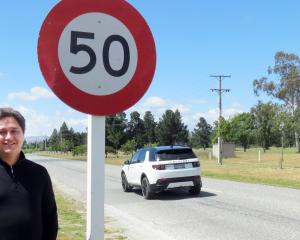Gillian Vine visits a farm garden on the outskirts of Gore.
When Dianne and Stuart Hamlin took over Spylaw Farm from Dianne’s grandparents’ estate in October 2006, she saw lots of scope for developing the garden.
"There were only a few established trees, including a large spreading elm, two rhododendrons in a lawn and a small garden around the house," she said.
The elm and rhododendrons were kept and the garden enlarged with more trees and rhododendrons, as well as roses, other shrubs, bulbs and perennials.
"It is a difficult site, as it sits on top of a hill and the ground is rotten rock," Dianne explained.
She does all the garden, although Stuart mows the lawns "and does the manual labour if I need it".
With very little top soil to start with, Dianne has spent years building up the ground, mainly with pea straw and horse manure — the Gore racecourse area being a rich source of the latter.
Her efforts have paid off, as everything seems to thrive.
"I just let the garden evolve naturally," she said.
Trees have been carefully sited so they don’t block the views.

Not often seen now is a medlar (Mespilus germanica), a fruit tree that has been cultivated in Europe for at least 2000 years.
It has shiny dark green foliage and white flowers in spring.
"It does have lots of fruit," Dianne said, but given that when it is ready to eat, the fruit has to be virtually rotten — a process called bletting — she has yet to make use of it.
The Hamlins do, however, have a productive vegetable garden and spread pea straw between cabbages, cauliflowers and silverbeet to keep weeds down.
Worked in after the vegetables are harvested, the straw helps enrich the ground.
When, several years ago, she and Stuart built a retaining wall to level out a sloping bank and create a parking area, Dianne put troughs of alpines at the base, an effective link to the garden above the wall.
Elsewhere, paeonies, both herbaceous and tree varieties, are a spring delight, enhanced by the rhododendrons, and at ground level, lots of bulbs and perennials including trilliums.
A newly developed area on a slope below the main flower garden "is coming along", Dianne said.
"I’ve put wee treasures in there, quite a variety of wee things — lots of daffodils, some little alpine phlox and a couple of trees and rhododendrons.
"They seem to be doing OK; so far, so good.
"There are roses to mix in, too.

Some old roses came from the Gore Public Gardens when they were revamped.
Unfortunately, they had no names, but Dianne was delighted to be able to save them.
She loves all seasons, especially spring, so it’s no surprise that bulbs are among her favourite plants, although alpines rate highly too.
In addition to developing and maintaining her own garden, Dianne looks after the grounds at Gore’s four cemeteries, cares for the hellebore bank and heritage orchard at the town’s Bannerman Park and works at Dolamore Park, 11km outside Gore.
There, she tends the rhododendrons up the road to the old residence and, with the removal of conifers, she will have more work, as the old trees are being replaced with rhododendrons.
"I’m going to choose all the rhododendrons and plant them out," she said, clearly delighted at the prospect.
If the success of Dianne’s rhododendrons at Spylaw Park is any guide, the new plantings at Dolamore Park promise to be stunning.















